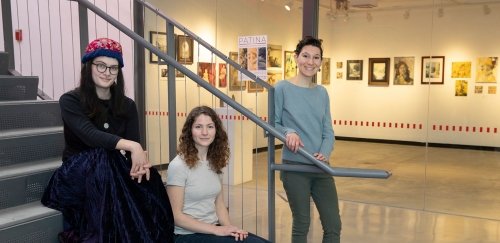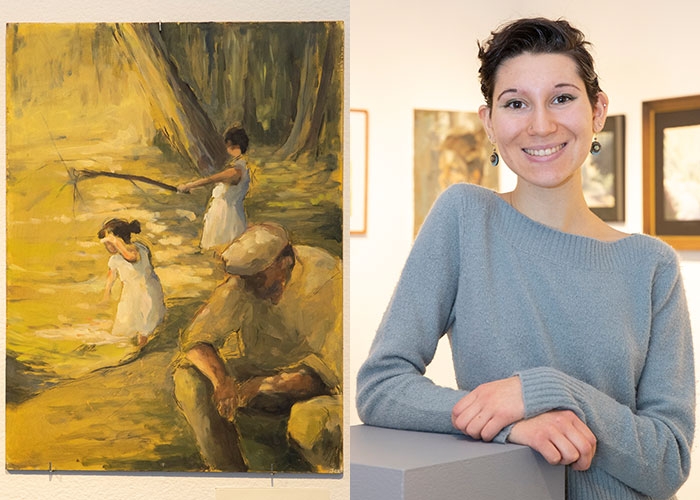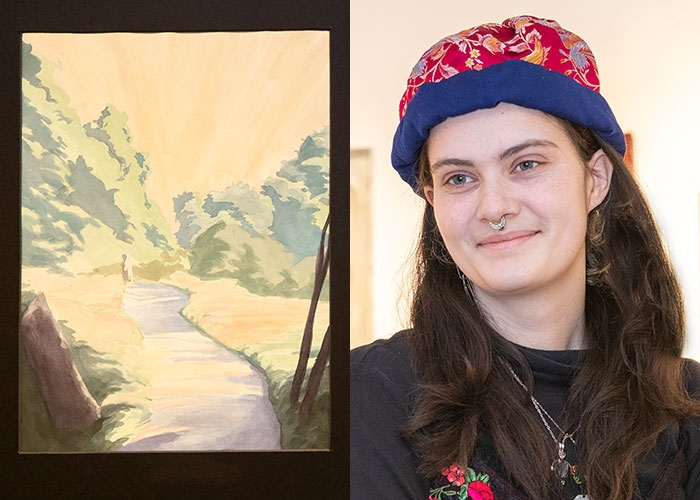Student Art Exhibit Explores the Nature of Memory
- News & Events
- News
- Student Art Exhibit Explores the Nature of Memory

This exhibit runs through Feb. 28.
An exhibit of 40 artworks titled “Patina” are on display at the Chazan Family Gallery through Feb. 28. The woodblock prints, drawings and paintings were produced by RIC students Gabrielle Patrone, Erica Tedesco and Serene Lincoln.
“In these works, we explore the nature of time and memory,” Patrone says, who is both curator of the exhibit and exhibiting artist. In these explorations, the artists discover that memory is always colored. Memory always alters reality.
In her oil paintings, Patrone starts with old, black-and-white photos of family events and gatherings. “I’m from an Italian family, where get-togethers are highly valued,” she says. “All of my paintings are snapshots of those moments.”

Taken during the 1950s, the photos depict events Patrone herself was not a part of. “All I have are the stories that were passed down,” she says. “My paintings are reinterpretations of those stories.” In her paintings, Patrone takes the actual event as seen in the photos and infuses it with her own imagination and the feelings she experienced when she heard the stories.
*****
All of the self-portraits in the show were painted by Erica Tedesco. To produce them, she would gaze into two mirrors and then paint what she saw using oil on canvas. What she discovered is that what we see is not what we remember.
Not only do “human beings have short-term memories,” Tedesco says, our emotions and personal perceptions affect what we remember. “How we perceive the present is going to influence how we remember it, which is why what we see can never be accurate,” she says.
Tedesco notes that her more successful self-portraits are the ones that look the least like her – the ones that verge on the abstract. Abstraction removes the self-portrait from having to be technically accurate.

*****
All the landscapes in the show – both watercolor paintings and woodblock prints – were created by Lincoln. They depict the grounds of a former monastery in Cumberland, Rhode Island, along with the Cistercian monks who once lived there.
“The monastery has been a part of my life ever since I could walk these grounds,” Lincoln says. “I feel very connected to the land and to all the people who’ve interacted with this land.”

For this project, Lincoln undertook in-depth research on the Cistercian order – how they lived and how they worked the land.
“I wanted to give life to these figures of the past,” she says. “Unlike Gabrielle and Erica, I’m not using my own memories or the memories of others in my work. I’m using ‘imagined memories.’”
“When I started this project, I was very invested in making my paintings look like what I was seeing. But memory isn’t just what you see; it’s how you perceive [identify / draw conclusions from] what you see,” she says.
Like Tedesco, whose most successful paintings are the ones that verge on the abstract, Lincoln’s favorite landscapes in the show are the ones where the viewer can’t make out what an object is.
“You look at it and can’t tell if it’s a tree or a stump,” she says. “The shapes themselves are actually more interesting to me when they’re indecipherable. They lose their context and just become shapes in a painting that are interesting to look at. That was an important discovery for me. Memory itself is fickle, so, why not allow my art to be, as well.”
*****
Gabrielle Patrone is a senior, earning a B.F.A. in painting and a B.A. in art history. She hopes to become a curator at a museum or to teach art history. Of her education at RIC, she says, “The professors in the Art Department have had a significant impact on me. They pushed me to pursue this gallery exhibition, and they’re big supporters of going to graduate school and furthering your education. They require all art majors to take the ART 400 course to make sure we’re ready to work in any art field, whether it be fine arts, teaching art or curating.”
Erica Tedesco is a senior earning a B.F.A. in painting and a B.S. in biology. She hopes to become a career artist and to teach. She says, “The faculty in both art and biology are hard. But it’s good. It toughens you up. They want to give you a realistic picture of what it’s like in the professional world.” Before enrolling in graduate school, Tedesco will work for a few years in a research lab at a biotech company to make use of her biology degree. After that, she intends to pursue art full time.
Serene Lincoln, who graduated last semester, earned a B.F.A. in printmaking and a B.A. in painting. She intends to become a career artist, exhibiting and selling her work, while teaching at a school or working at a print shop. In looking back at her time at RIC, she says, “I came here because Rhode Island College was affordable, but you also get a solid education. The facilities are amazing, and the Art Center is just a phenomenal space. A lot of the art faculty worked at RISD or earned their degrees at Yale, one of the top art schools in the country. So, the education here is really solid.
“You also get a lot of one-on-one attention from your professors that you don’t get at bigger schools. I think that’s much more valuable. It’s where real learning happens. And you’re able to have constant interactions with your classmates. You can walk around and talk to people about what they’re working on, ask questions, ask them to take a look at your work and give you some pointers. I found that my professors – especially Richard Whitten and Stephen Fisher – were hard, but I’ve seen my understanding of art and my own art grow in a very short amount of time. I think they got me ready for the real world.”
See Department of Art for information about our program.
